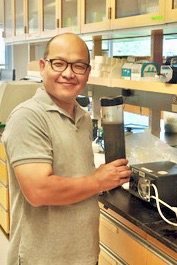
Bongkeun Song
Professor of Marine Science; Chair, Ecosystem Health
Email:
songb@vims.edu
Phone:
(804) 684-7411
Office:
Andrews Hall 328
Section:
Ecosystem Health
Interests:
Microbiome ecology and biogeochemistry
Fax:
(804) 684-7399
Education
- B.S., Agriculture Biology, Dongguk University, Seoul, Korea, 1994
- M.S., Environmental Science, Rutgers the State University of New Jersey, New Brunswick, New Jersey, 1997
- Ph.D., Environmental Science, Rutgers the State University of New Jersey, New Brunswick, New Jersey, 2000
Research Interests
My research focuses to understand the fundamental roles of microbiomes in biogeochemical carbon and nitrogen cycles, microplastic pollution, and marine organismal health. I have employed various techniques in isotope biogeochemistry, metagenomics, and bioinformatics to examine microbiome parameters, including abundance, composition, diversity, and activities in environmental samples and marine invertebrates. In addition, Raman microspectroscopy has been used to identify and quantify microplastics in water samples.
Research Topics
- Microbial carbon and nitrogen cycling in estuarine ecosystems
- Microbiomes associated with marine organisms
- Microbiomes and harmful algal blooms
- Microplastic detection and quantification in natural and engineered environments
- Impacts of microplastics on microbiomes and marine organisms
- Synthetic microbiomes in nitrogen cycling
- Environmental DNA (eDNA) analysis for water quality monitoring and benthic community survey
Current Projects
- Estuarine dam removal as an ecosystem disturbance: Examining the impacts of seawater intrusion on functional stability of benthic N cycle communities (funded by NSF Division of Environmental Biology)
- Elucidating the occurrence of known and emerging chemical contaminants in wastewater biosolids and the influence of treatment and management processes on their fate, mobility and bioavailability (funded by EPA)
- Biotechnology to enhance oyster seed production in shellfish aquaculture industries (Funded by NOAA Saltonstall-Kennedy Grant)
- Sediment eDNA illustrating the impacts of estuarine dams on benthic ecosystems in the Nakdong, Youngsan, and Geum River estuaries and coasts (Funded by Korea National Research Foundation)
Selected Publications
- Wilson, S. J., I. C. Anderson, B. Song, C. R. Tobias (2023) Temporal and spational variation in subterranean estuary geochemical gradients and nutrient cycling rates: impacts on groundwater nutrient export to estuaries. Journal of Geophysical Research: Biogeosciences, 128, e2022JG007132. https://doi.org/10.1029/2022JG007132.
- Semedo, M., B. Song (2023) Sediment metagenomics reveals the impacts of poultry industry wastewater on antibiotic resistance and nitrogen cycling genes in tidal creek ecosystems, Science of the Total Environment, 857, 159496. https://doi.org/10.1016/j.scitotenv.2022.159496
- Pimentel, Z., P. Thibodeau*, B. Song, Y. Zhang (2022) A Mollicutes Metagenome-Assembled Genome from the Gut of the Pteropod Limacina rangii, Microbiology Resource Announcements, https://doi.org/10.1128/mra.00752-22.
- Lisa, J. A., B. Song, M. Semedo, K. A. Duernberger, C. R. Tobias (2022) Determining geochemical and microbial parameters underlying geographic patterns of denitrification and anammox rates in the New River Estuary, North Carolina, USA. Estuarine Coastal and Shelf Science, 275, 107973. https://doi.org/10.1016/j.ecss.2022.107973.
- Fortin, S., B. Song, I. Anderson, K. R. Reece (2022) Blooms of the Harmful Algae Margalefidinium polykrikoides and Alexandrium monilatum Alter the York River Estuary Microbiome. Harmful Algae, 114, 102216. https://doi.org/10.1016/j.hal.2022.102216
- Thibodeau, P.*, B. Song, C. Moreno, D. Steinberg (2022) Feeding ecology and microbiome of the pteropod Limacian helicina antarctica. Aquatic Microbial Ecology, 88, 19-24.Fortin, S., B. Song, I. Anderson (2021) Microbially mediated nitrogen removal and retention in the York River Estuary, FEMS Microbiology Ecology, 97, fiab118. https://doi.org/10.1093/femsec/fiab118.
- Wilson, S., B. Song, R. Phillips (2021) Determining chemical factors controlling abiotic codenitrification. ACS Earth and Space Chemistry, 5:186-196, https://doi.org/10.1021/acsearthsapcechem.0c00225.
- Arfken, A., B. Song, S. Allen, R. Carnegie (2021) Comparing larval microbiomes of the eastern oyster (Crassostra virginia) raised in different hatcheries. Aquacultures, 531, 735955. https://doi.org/10.1016/j.aquaculture.2020.735955
- Semedo, M., L. Wittorf, S. Hallin, B. Song (2020) Differential expression of clade I and II N2O reductase genes in denitrifying bacterium Thauera linaloolentis 47LolT under different nitrogen conditions. FEMS Microbiology Letters, fnaa205, https://doi.org/10.1093/femsle/fnaa205.
- Hale, R. C., Song (2020) Single-use plastics and COVID-19: scientific evidence and environmental regulations, Environmental Science & Technology, DOI: 10.1021/acs.est.0c02269.
- Seeley, M. E., Song, R. Passie, R. C. Hale (2020) Microplastics affect sedimentary microbial communities and nitrogen cycling, Nature Communication, 11:2372, https://doi.org/10.1038/s41467-020-16235-3
- Park, Y., J. Cha, Song, H. Yan, S. Kim, S. Kim, E. Jo, S. Fortin, S. An (2020) Total microbial activity and sulfur cycling microbe changes in response to the development of hypoxia in a shallow estuary, Ocean Science Journal, 55: 165-181. https://doi.org/10.1007/s12601-020-0011-0
- Semedo, M., Song (2020) From genes to nitrogen removal: determining the impacts of poultry industry wastewater on tidal creek denitrification, Environmental Science & Technology, 54: 146-157. https://doi.org/10.1021/acs.est.9b03560
- Fortin, S., Song, C. Burbage (2019) Quantifying and identifying microplastics in the effluent of advanced wastewater treatment systems using Raman micrometric. Marine Pollution Bulletin, 149, 110579. https://doi.org/10.1016/j.marpolbul.2019.110579
- Smith, R. L., D. A. Repert, D. L. Stoliker, D. B. Kent, Song, D. R. LeBlanc, T. D. McCobb, J. K. Böhlke, S. P. Hyn and H. S. Moon (2019) Seasonal and spatial variation in the location and reactivity of a nitrate-contaminated groundwater discharge zone in a lakebed. Journal of Geophysical Research-Biogeosciences, 124, https://doi.org.10.1029/2018JG004635.
- Yoon, S. Song, R. L. Phillips, J. Chang and M. J. Song (2019) Ecological and physiological implications of nitrogen oxide reduction pathways on greenhouse gas emissions in agroecosystems. FEMS Microbiology Ecology, 95: fiz066. https://doi.org/10.1093/femsec/fiz066
- Han, H., Song and S. Yoon (2019) Salt and alkaline stresses disrupt nitrous oxide balance in the denitrification pathway in Dechloromonas aromatic strain RCB. Frontiers in Microbiology, 10: 1203.
- Murphy, A. E., R, Kolkmeyer, Song, I. C. Anderson and J. Bowen (2019) Bioreactivity and microbiome of biodeposits from filter feeding bivalves. Microbial Ecology, 77: 343–357.
- Hong, Y., J. W, S. Wilson and Song (2019) Vertical stratification of sediment microbial communities along geochemical gradients of a subterranean estuary located at the Gloucester beach of Virginia, USA. Frontiers in Microbiology, https://doi.org/10.3389/fmicb.2018.03343.
- Semedo, M., Song, T. Sparrer and R. L. Phillips (2018) Antibiotic effects on microbial communities responsible for denitrification and N2O production in grassland soils. Frontiers in Microbiology 9:2121. Doi: 10.3389/fmicb.2018.02121.
